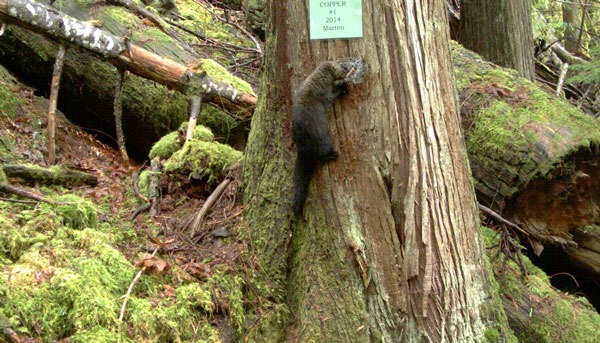By the end of October the survey season for the researchers studying the fisher population on the Olympic Peninsula will draw to a close until the next survey season in June. Since the species’
reintroduction in 2008, fishers continue to roam the peninsula, but just how many and whether they have reached a self-sustaining population still is hard to predict.
“In some ways it has been long enough to begin to recognize trends, but it really hasn’t been long enough to make any firm conclusions whether the fisher population is self-sustaining,” Betsy Howell, wildlife biologist with Olympic National Forest, said.
Brief background
Fishers, a house cat-sized member of the weasel family with close relatives being the mink, otter and marten, used to dwell in Washington, including on the Olympic Peninsula. However, by the mid-1900s fishers were extirpated because of over-trapping and loss of habitat. After being determined an endangered species in Washington in 1998 by the Washington Fish and Wildlife Commission, conservation efforts began to take action.
In an attempt to revive a fisher population in Washington, 90 fishers from British Columbia were translocated to Olympic National Park.
Seven years later staff from a variety of organizations that involve three lead agencies, Olympic National Park, the U.S. Geological Survey and Washington Department of Fish and Wildlife, as well as Olympic National Forest, tribal entities, Conservation Northwest, U.S. Fish and Wildlife Service and Jefferson Land Trust, continue to collaborate to document the fishers.
Although the original fishers were introduced within the boundaries of Olympic National Park, they have since widely dispersed to various parts of the peninsula and therefore require the cooperation of many landholders to effectively monitor the reintroduction.
Research techniques
“The goal of the reintroduction is to have a self-sustaining fisher population on the peninsula,” Howell said.
In order to determine the status of that goal, Howell and her fellow scientists focus their research on four aspects including the fishers’ movement, reproduction, whether they’re establishing home ranges and survival.
For the first phase of research scientists were able to use radio telemetry to monitor the animals because the original fishers released wore radio collars. But, because the radio collars were designed to last three to five years, by December 2011 the first phase was complete, as most of the collars had either failed, the batteries had died or the individual fisher had died.
By the end of the first phase “seven dens had been located and a massive amount of data collected on where the animals were settling and how well they were surviving,” Howell said.
Scientists have since shifted their research approach during the second phase to rely on cameras and non-invasive DNA collection via hair snares. Throughout the Olympic Peninsula, including the Sequim-Dungeness Valley, “survey polygons” are scattered about, each site including three cameras and three hair snares, Howell said.
“The founder animals all had DNA profiles constructed, using blood and hair samples, and so now it is possible to match hair obtained from their descendants to those released individuals from five to seven years ago,” Howell said.
In this survey season, fishers have been documented at three survey areas and the genetic results are still pending, Howell said. In last year’s survey season, fishers were documented at nine study sites and 10 fishers were identified with photograph and DNA analysis, Howell said. Five of the 10 identified were not among the original translocated fishers, which may hint toward successful reproduction.
Why reintroduce fishers?
Because fishers were once part of the Olympic Peninsula’s ecology, they have a historical impact on plant and small animal communities that has long been gone from the area since the fishers’ absence. Fishers, as mid-sized carnivores, tend to prey on things like snowshoe hares and mountain beavers. Fishers also can influence the plant community and aid in the transfer of nutrients throughout their environment, Howell explained.
From a forestry stance, fishers often are looked upon a positive species because they are one of few predators to prey on porcupines, which tend to damage timber.
“Because we can’t understand everything, the wisest thing we can do as land managers is try to maintain habitats that allows for ecosystem function,” Howell said.
The reasons why each agency is involved in the reintroduction of fishers really depends on the purpose of the agency, Howell said. For example, Olympic National Forest has different land management practices then Olympic National Park because they have differing purposes, yet they both foresee a land management benefit to maintaining diversity.
“I’ve never been involved in a reintroduction project like this and it is such a privilege to get to see this process from the beginning,” Howell said. “So far it has been a great experience.”
For more information on the fisher reintroduction, visit http://pnw.cc/DtZCP.
Reach Alana Linderoth at alinderoth@sequimgazette.com.



